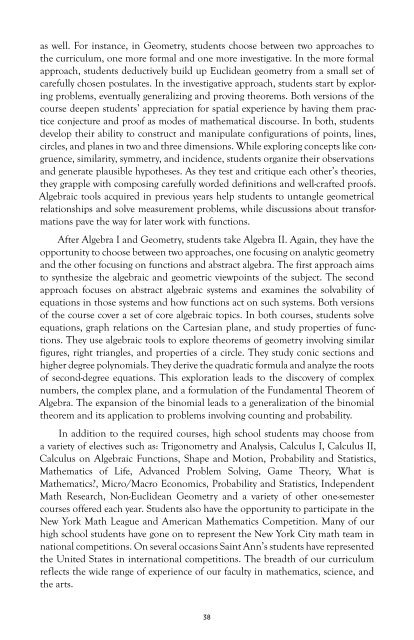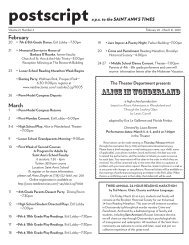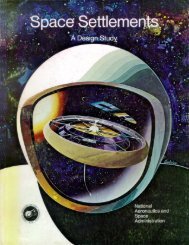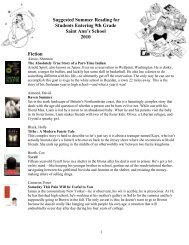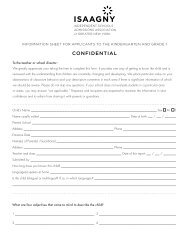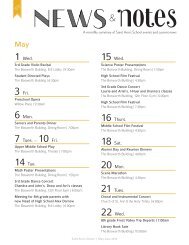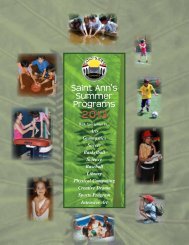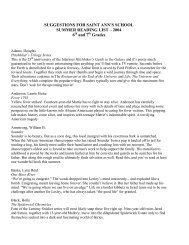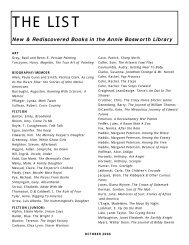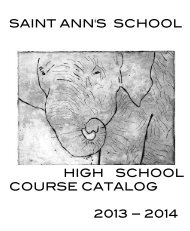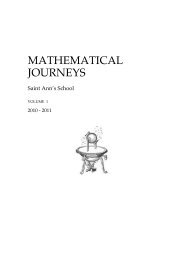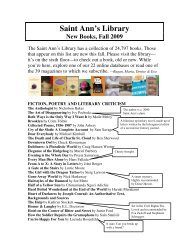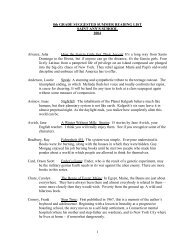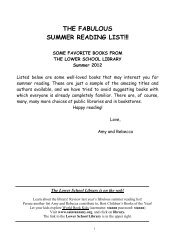Saint Ann's School Curriculum - An Overview
Saint Ann's School Curriculum - An Overview
Saint Ann's School Curriculum - An Overview
You also want an ePaper? Increase the reach of your titles
YUMPU automatically turns print PDFs into web optimized ePapers that Google loves.
as well. For instance, in Geometry, students choose between two approaches to<br />
the curriculum, one more formal and one more investigative. In the more formal<br />
approach, students deductively build up Euclidean geometry from a small set of<br />
carefully chosen postulates. In the investigative approach, students start by exploring<br />
problems, eventually generalizing and proving theorems. Both versions of the<br />
course deepen students’ appreciation for spatial experience by having them practice<br />
conjecture and proof as modes of mathematical discourse. In both, students<br />
develop their ability to construct and manipulate configurations of points, lines,<br />
circles, and planes in two and three dimensions. While exploring concepts like congruence,<br />
similarity, symmetry, and incidence, students organize their observations<br />
and generate plausible hypotheses. As they test and critique each other’s theories,<br />
they grapple with composing carefully worded definitions and well-crafted proofs.<br />
Algebraic tools acquired in previous years help students to untangle geometrical<br />
relationships and solve measurement problems, while discussions about transformations<br />
pave the way for later work with functions.<br />
After Algebra I and Geometry, students take Algebra II. Again, they have the<br />
opportunity to choose between two approaches, one focusing on analytic geometry<br />
and the other focusing on functions and abstract algebra. The first approach aims<br />
to synthesize the algebraic and geometric viewpoints of the subject. The second<br />
approach focuses on abstract algebraic systems and examines the solvability of<br />
equations in those systems and how functions act on such systems. Both versions<br />
of the course cover a set of core algebraic topics. In both courses, students solve<br />
equations, graph relations on the Cartesian plane, and study properties of functions.<br />
They use algebraic tools to explore theorems of geometry involving similar<br />
figures, right triangles, and properties of a circle. They study conic sections and<br />
higher degree polynomials. They derive the quadratic formula and analyze the roots<br />
of second-degree equations. This exploration leads to the discovery of complex<br />
numbers, the complex plane, and a formulation of the Fundamental Theorem of<br />
Algebra. The expansion of the binomial leads to a generalization of the binomial<br />
theorem and its application to problems involving counting and probability.<br />
In addition to the required courses, high school students may choose from<br />
a variety of electives such as: Trigonometry and <strong>An</strong>alysis, Calculus I, Calculus II,<br />
Calculus on Algebraic Functions, Shape and Motion, Probability and Statistics,<br />
Mathematics of Life, Advanced Problem Solving, Game Theory, What is<br />
Mathematics?, Micro/Macro Economics, Probability and Statistics, Independent<br />
Math Research, Non-Euclidean Geometry and a variety of other one-semester<br />
courses offered each year. Students also have the opportunity to participate in the<br />
New York Math League and American Mathematics Competition. Many of our<br />
high school students have gone on to represent the New York City math team in<br />
national competitions. On several occasions <strong>Saint</strong> <strong>An</strong>n’s students have represented<br />
the United States in international competitions. The breadth of our curriculum<br />
reflects the wide range of experience of our faculty in mathematics, science, and<br />
the arts.<br />
ReCReAtIONAL ARtS<br />
<strong>Saint</strong> <strong>An</strong>n’s recreational arts curriculum is rooted in the idea of providing a<br />
positive, creative, safe environment in which to foster an awareness of the value of<br />
physical activity and athletics. We are committed to engaging students in a process<br />
that will enhance their lives now and in the future.<br />
Physical fitness is a lifelong objective. Our classes and activities from preschool<br />
through twelfth grade reflect this belief, putting substantial emphasis on<br />
the idea that the experience should be a joyful one. Students are encouraged to<br />
explore our physical education and athletic offerings not only to enhance their<br />
health, but also to learn the lessons inherent in trying new things, competing and<br />
facing challenges.<br />
The foundation of our program is taught in the Preschool and Lower<br />
<strong>School</strong>. During these years the children receive their initial exposure to movement.<br />
Constantly moving, they touch, climb on, jump over, balance across, and<br />
run toward any obstacle or challenge we offer, and we offer plenty! By the time<br />
they have reached third grade, they have explored movement in relation to space,<br />
time, and form, learned basic skills in team and individual sports, and learned to<br />
interact in large and small groups, working toward a shared goal.<br />
In the fourth grade, a challenging transition occurs. Each child must negotiate<br />
his or her own complex, departmentalized middle school schedule. Individual<br />
attention is given to ensure a positive adaptation to the new and often larger gym<br />
classes with older children. Fourth, fifth, and sixth graders continue to develop<br />
through drills and game-playing experience, with an emphasis on rules and beginning-level<br />
strategies. Our lunch-time intramural program is open to all Lower<br />
Middle <strong>School</strong> students, often providing them with their first chance to be a member<br />
of a team.<br />
Seventh and eighth grade students refine the skills they have learned in the<br />
earlier grades. They are ready to use more complex individual and team strategies<br />
in sports and to challenge themselves and each other at a higher level. In addition<br />
to the “traditional” sports curriculum, these challenges can be achieved through<br />
alternative activities such as badminton, bocce, indoor climbing, ultimate Frisbee,<br />
fitness room, and jump rope, as well as through electives in exercise, fencing, karate,<br />
yoga, and inward bound (adventure training). The Upper Middle <strong>School</strong> students<br />
may join interscholastic teams in baseball, basketball, fencing, gymnastics, soccer,<br />
softball, track and field, and volleyball.<br />
We use team teaching to maximize student-teacher interaction, and we<br />
organize the classes according to age. This method provides an opportunity for<br />
individualized attention and skill development. During the fall and spring our<br />
classes are conducted outdoors; in the winter, we teach classes in our large and<br />
small gymnasiums, fitness room and our apparatus room.<br />
38 39


